The Old Moon Covers Jupiter Near Saturn in Morning and Moonless May Evenings Let us Peruse the Ploughman!
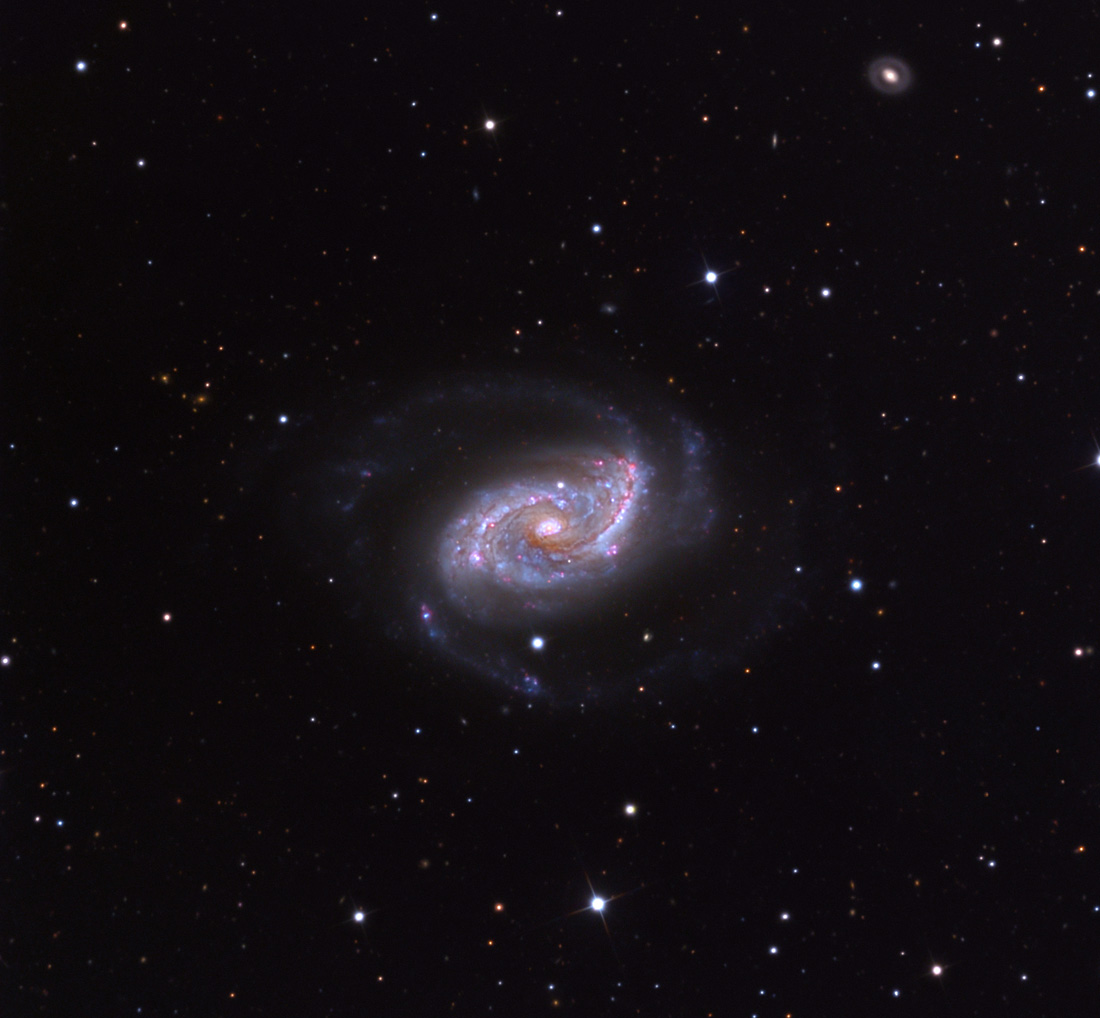
This gorgeous spiral galaxy named NGC 5248 and Caldwell 45 in Boötes is visible in medium-sized and larger telescopes on moonless evenings. Image by Adam Block of Mount Lemmon Observatory (Wikipedia)
Hello, Moonless May Stargazers!
Here are your Astronomy Skylights for the week of May 14th, 2023 by Chris Vaughan. Feel free to pass this along to your friends and send me your comments, questions, and suggested topics. You can also follow me on Twitter as @astrogeoguy! Unless otherwise noted, all times are expressed in Eastern Time. To subscribe to these emails please click this MailChimp link.
If you’d like me to bring my Digital Starlab portable inflatable planetarium to your school or other daytime or evening event, or deliver a session online, contact me through AstroGeo.ca, and we’ll tour the Universe, or the Earth’s interior, together! My terrific book with John A. Read entitled 110 Things to See With a Telescope is a guide to viewing the deep sky objects in the Messier List – for both beginners and seasoned astronomers. DM me to order a signed copy!
The moon will begin the week visiting Saturn before sunrise and then occulting Jupiter in early morning. After Friday’s new moon, it will join the western post-sunset sky. This week’s moonless evenings worldwide will be ideal for viewing spring galaxies and the touring the stars and sights of Boötes the Ploughman. Meanwhile, the bright planets are shared between evening and pre-dawn. Read on for your Skylights!
The Moon
This week, stargazers around the world will be treated moonless nights. That’s because Earth’s celestial sibling will be making its monthly trip past the sun. Check the overnight weather forecasts and head outside with your binoculars and telescopes!
If you have to leave the house before sunrise on Monday morning, cast your gaze above the eastern horizon to a see the waning crescent moon. The pretty, 20%-illuminated moon will shine in southwestern Pisces (the Fishes), and share the brightening sky with Saturn in next-door Aquarius (the Water-Bearer). The planet Neptune will be located several finger widths to the upper right of the moon, too – but it’ll be too faint to see easily. You should have no trouble seeing the moon as a slimmer crescent on Tuesday, too – but it will be lower and farther from Saturn.
On Wednesday morning, the very slim crescent of the old moon will shine very closely to the right (or celestial southwest) of Jupiter’s bright dot. Observers viewing them from southerly latitudes will see them, plus nearby Mercury, more easily. Anyone located in northern Central America, the northern Caribbean, most of North America, Greenland, Iceland, Svalbard, the northern British Isles, Scandinavia, and northwest Russia can watch the bright, leading edge of the moon pass in front of, or occult, Jupiter starting around 7:40 am EDT or 4:40 am PDT and 11:40 Greenwich Mean time. Jupiter will emerge from behind the dark edge of the moon about 70 minutes later. The times vary by locations, so use an app like Stellarium or Starry Night to look up your own circumstances. For all but the most westerly locations, the event will occur in daylight, making finding the moon and Jupiter a challenge. Binoculars and backyard telescopes will show the event, but extra caution must be taken to avoid pointing optics anywhere near the sun.
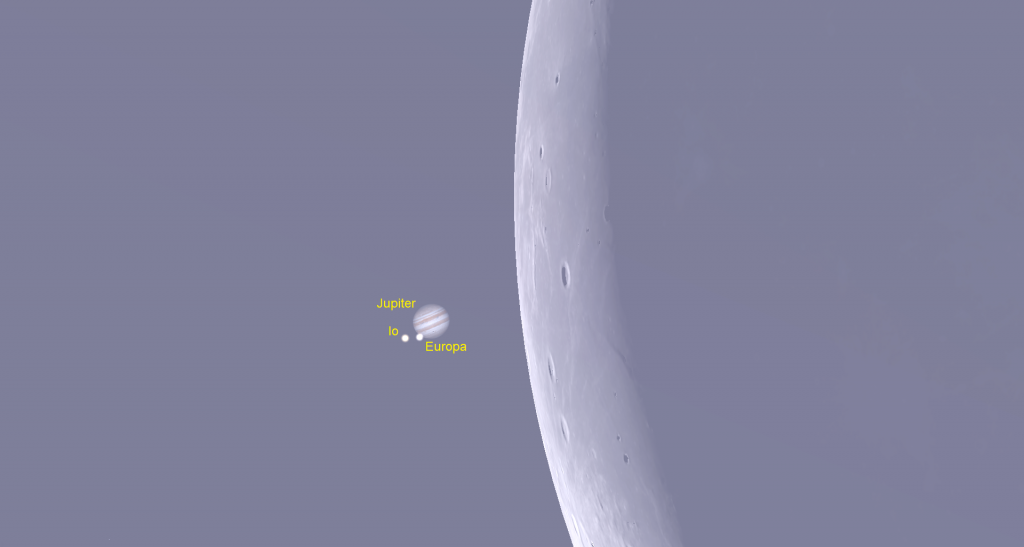
A day after the moon’s close encounter with Jupiter, its razor-thin crescent will hop east to form a bent line with Jupiter and the much fainter dot of Mercury. The trio will appear in the brightening sky above the east-northeastern horizon just before sunrise. The moon will shine a fist’s diameter to the lower left of Jupiter. Mercury will be positioned below the midway point between them. Binoculars will assist in your search, but turn all optical aids away before the sun rises. Skywatchers viewing the trio from tropical latitudes and the Southern Hemisphere will see them more easily, but their line will be rotated up-down.
On Friday, May 19 at 11:53 am EDT, 8:53 am PDT, or 15:53 GMT, the moon will officially reach its new moon phase. At that time our natural satellite will be located in Taurus (the Bull), and less than 2 degrees north of the sun. While at its new phase, the moon is travelling between Earth and the sun. Since sunlight can only shine on the far side of the moon, and the moon is in the same region of the sky as the sun, it becomes completely hidden from view from anywhere on Earth for about a day (unless there’s a solar eclipse).
On Saturday after sunset the near-vertical ecliptic will allow sharp-eyed observers in the Americas to see the very young crescent moon, only 2%-illuminated, shining above the west-northwestern horizon. While the sky is darkening, around 9 pm local time, search for it about a fist’s width above the horizon. The moon will set around 10 pm. On Sunday night, the more substantial waxing crescent moon will shine to the lower right of bright Venus. Watch for earthshine to brighten the unlit portion of the moon, too. The surrounding stars of Taurus (the Bull) might start to twinkle before the moon sets around 11 pm local time.
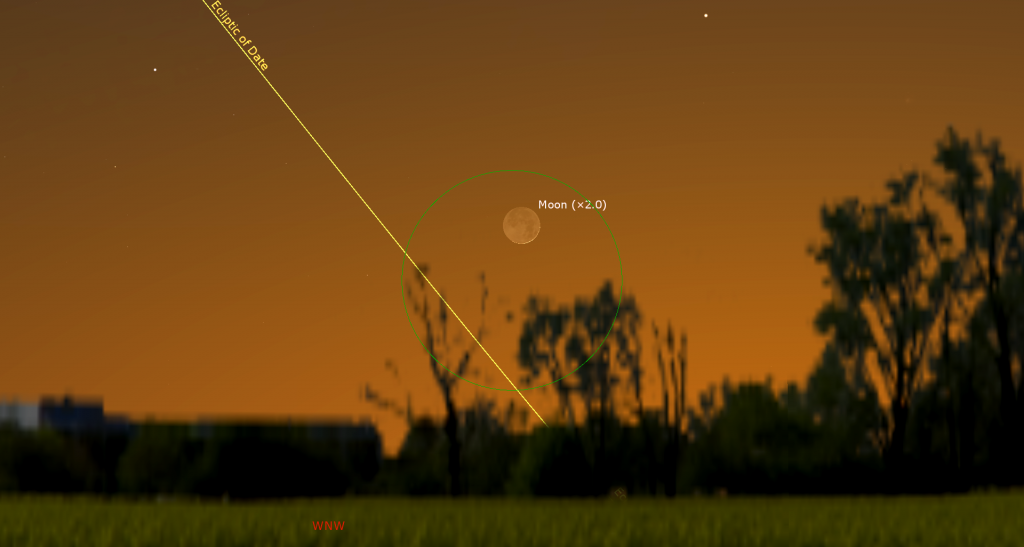
The Planets
Since ancient times, humans who watch the sky have noted that, aside from the sun and moon, only a handful of bright objects move with respect to the background stars. Our English word planet comes from the ancient Greek word planetes, or “wanderer”. The planet names we use in Western modern astronomy are derived from the Roman counterparts of the Greek deities – Mercurius (Hermes), Venus (Aphrodite), Mars (Ares), Iuppiter (Zeus) and Saturnus (Cronus). Societies that pre-dated the Greeks had their own naming conventions, and so did the many other cultures worldwide that had no contact with the Greco-Roman astronomers, such as the Chinese, Mayans, and South Sea Islanders among others.
Interestingly, many naming systems included the sun and moon in the “family” of planets – bringing the total to seven objects. The Germanic / Norse cultures’ planetary naming system serves double duty as our days of the week. Saturn, sun, and moon cover three days. Their Anglo-Saxon gods Tīw or Týr, Wōden, Þunor or Thor, and Frīġ are similar or equivalent to the Romans’ Mars, Mercury, Jupiter, and Venus, respectively – giving us “Tuesday, Wodensday, Thorsday, and Fri(s)day”.
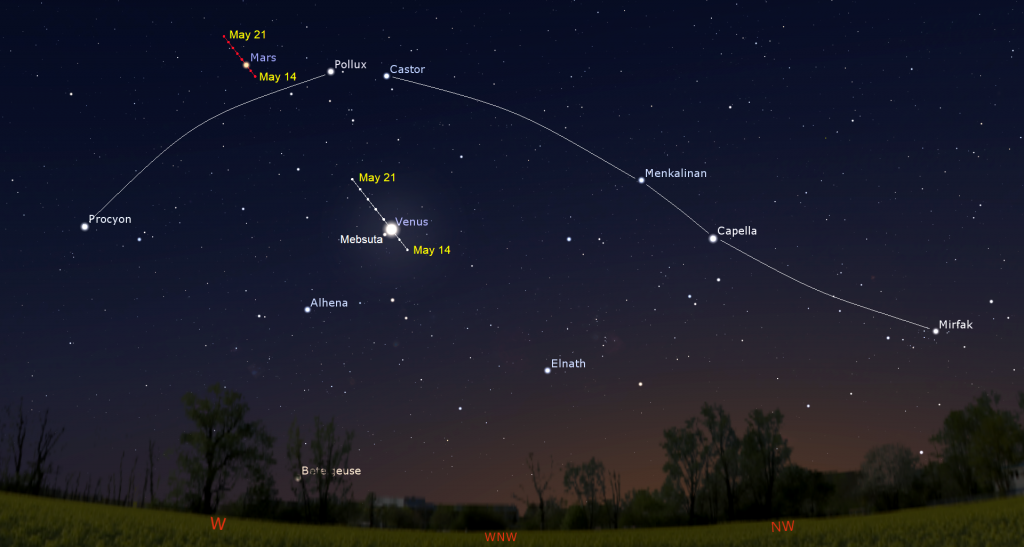
Venus will set at about midnight this week. Each night, the stars around it will drop a little lower and sunward, causing Venus to shift “higher” compared to them. This week, the motion of the bright planet Venus will be particularly apparent when it slides closely past the bright star Mebsuta, or Epsilon Geminorum. In the western sky after dusk on Sunday and Monday evening, Venus will shine a small distance to the lower right (or celestial west-northwest) of the much fainter star. On Tuesday night, Venus will slide less than a finger’s width to the upper right (or celestial north) of Mebsuta. Venus will shift rapidly higher and to the left of the star from Wednesday onwards. You can easily track Venus’ wandering with your unaided eyes, or through binoculars or a backyard telescope.
Magnitude -4.3 Venus will continue to gleam under the bright stars of the Arch of Spring asterism this week. From left to right (or celestial southeast to northwest of Venus) they are white Procyon (Alpha Canis Minoris), white Castor and golden Pollux (Alpha and Beta Geminorum respectively), yellowish Capella (Alpha Aurigae) with the fainter white star Menkalinan to its upper left, and the white star Mirfak in Perseus (the Hero). Two somewhat fainter stars named Alhena (Gamma Geminorum) and Elnath (Beta Tauri) will flank Venus, too. The arch is seven fist diameters wide!
Viewed in a telescope, our sister planet will display a slightly gibbous, 59%-illuminated disk that is waning daily. To see the planet’s shape most clearly, wait until the sun has fully set and then aim your telescope at Venus while the sky is still bright. That way Venus will be higher, shining through less intervening air, and her glare will be lessened.
The modest red dot of Mars will continue to shine in the western evening sky to the left of the stars Pollux and Castor. The planet’s reddish, magnitude 1.5 dot will resemble a star somewhat fainter than Pollux and a bit brighter than Castor. Like Venus, Mars will look best in a telescope while it’s highest – right at dusk – but its ruddy disk will look tiny under any magnification. Mars will set at about 1:30 am local time. On Tuesday, Mars’ easterly motion along the ecliptic will bring it into alignment with Pollux and Castor – a reddish triplet, perhaps?

The only other solar system object worthy of attention in the evening sky this week will be the minor planet designated (1) Ceres, the largest object in the main asteroid belt. The magnitude 7.9 object, which is visible in binoculars and backyard telescopes, will be creeping southward along the border between the constellations of Coma Berenices (Berenice’s Hair) and Leo (the Lion). Search for its speck about two finger widths to the left (or 2 degrees to the celestial east) of the very bright star Denebola. Ceres’ name is related to the word “cereal”, as both arise from the Greek Goddess of Agriculture. After its discovery by Italian astronomer Giuseppe Piazzi in 1801, it was thought to be the planet that was “missing” between the orbits Mars and Jupiter. Ceres was downgraded to asteroid status soon afterwards, and then upgraded to dwarf planet status in 2006 – on the same vote that demoted Pluto to the same class of objects.
The pre-dawn sky is getting busy! The bright, creamy-coloured dot of Saturn will clear the eastern horizon at 3 am local time and remain visible among the fainter stars of Aquarius (the Water-Bearer) until about 5 am. The waning crescent moon will shine to Saturn’s lower left on Monday and Tuesday morning. The moon will depart the scene, but the bright stars of the Summer Triangle asterism will sparkle above Saturn from now on. The ringed planet and the stars around it will rise about half an hour earlier each week, so you’ll see Saturn rising around midnight at the end of June, and then it’ll be available for your evening telescope viewing pleasure all summer and into mid-winter! The planet Neptune is located in western Pisces (the fishes), about two fist width to Saturn’s lower left. But it’s a bit too soon to chase down that faint, distant blue planet.
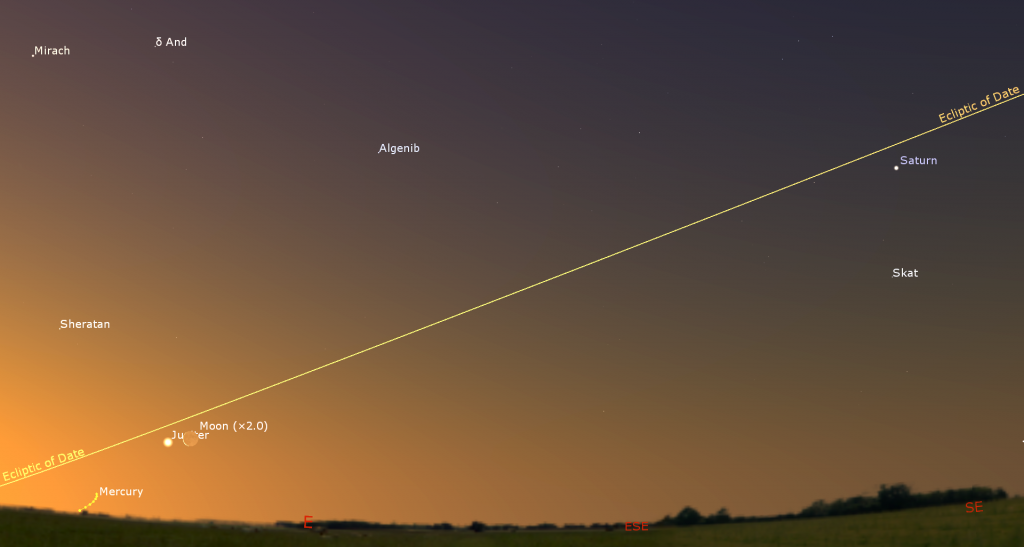
It’s definitely a good time to get a quality telescope. The giant planet Jupiter will rise about two hours after Saturn. They’ll share the summer sky, and then Jupiter will stick around until next March! Your telescope doesn’t need to be large to deliver fantastic views of the planets and the moon – but you’ll want one with a sturdy mount/tripod and optics that are free from chromatic aberration. Avoid big box stores and spend enough to get something that will last a lifetime.
This week, Jupiter will rise at about 5 am local time. It will appear about 16 times brighter than Saturn, so you’ll be able to see it gleaming just above the eastern rooftops until almost sunrise. The tilt of the morning ecliptic will keep the big planet relatively low in the sky for now. Observers at mid-northern latitudes will start seeing Jupiter more easily in a few weeks time – but, if you live at a southerly latitude, it’s already an easy target. A good thing, too – because there will be lots of occasions to see the shadows cast by its four Galilean moons cross the planet’s disk in pairs during May! Don’t forget that the moon will occult Jupiter on Wednesday morning, as I described above.
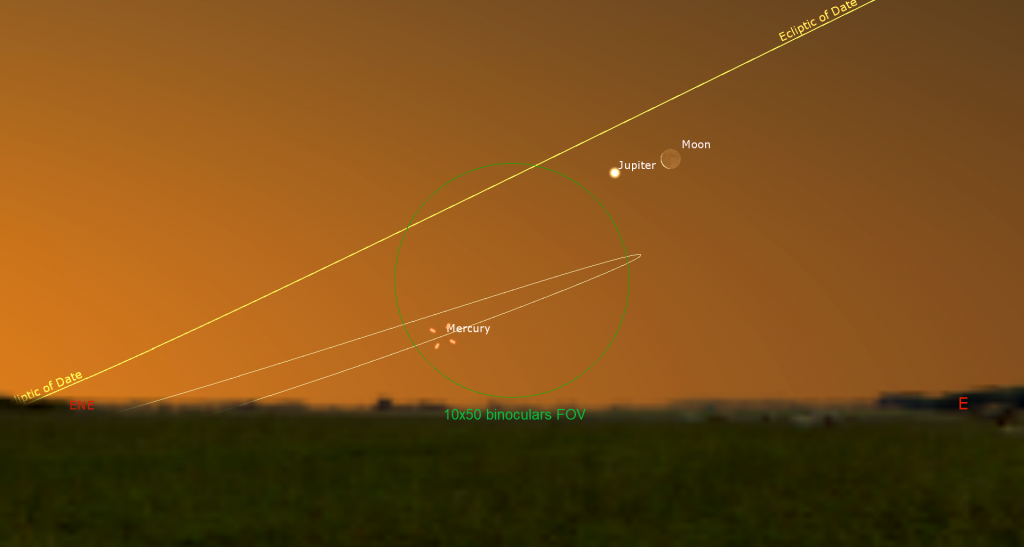
Mercury will gradually join the morning planet party as it swings farther from the morning sun. This week, Mercury will be located about a palm’s width to Jupiter’s lower left (or 6° to the celestial east) – but you’ll need a cloud-free, unobstructed eastern horizon to see it – unless you live near the tropics. Unfortunately, this will be a poor apparition of Mercury for viewers at mid-northern latitudes.
Perusing the Ploughman
The mild temperature, moonless evening skies this week offer a fine opportunity to explore the realm of Boötes (“Bow-OH-tees”), the Herdsman or Ploughman.

As the sky fully darkens, around 10 pm local time, face southeast and look two-thirds of the way up the sky for the very bright, orange-tinted star Arcturus (or Alpha Boötis). The fourth brightest star in the entire night sky, and a “neighbour” of our sun at a mere 37 light-years away, Arcturus means “Guardian/Watcher of the Bear” in Greek, because it always rises after Ursa Major (the Big Bear), which sits above it (celestial west) this month. Arcturus shines with that colour because it is just passing middle-age for a star, starting towards the red supergiant stage.
The entire constellation is visible from everywhere on Earth except Antarctica. In Chinese, Arcturus is known as Dà Jiǎo Xīng 大角星, “Great Horn Star”, part of the huge Azure Dragon of the East asterism, which stretches from Boötes and Virgo on the west to Scorpius and Sagittarius on the east. The star Antares marks the dragon’s heart.

Arcturus anchors the bottom tip of a large, kite-shaped asterism within the larger constellation of Boötes. The rest of the stars in the kite are bright enough to be visible under somewhat light-polluted skies and under any skies through binoculars. The kite measures 2.3 fist diameters on the long axis and a fist’s width across at its widest point. During spring evenings at mid-northern latitudes the kite extends upwards to the left from Arcturus. The full figure of Boötes strides over the ecliptic and the celestial equator, with his widely spaced feet stars closest to those two imaginary lines. The ecliptic and equator circles intersect in Virgo (the Maiden), about three fist diameters to Arcturus’ lower right (or 32 ° to the celestial southwest.
Virgo (the Maiden) occupies the sky below (south of) Boötes and the sinuous constellation of Draco (the Dragon) is above (north of) him. The ploughman is bordered on his left (celestial east) by Corona Borealis (the Northern Crown) and Hercules. His right-hand (westerly) neighbours are Coma Berenices (Berenice’s Hair) and Canes Venatici (the Hunting Dogs).
In May and June, Ursa Major and its Big Dipper asterism is located to the upper right of Boötes. In late summer the dipper drops to his right. Even when Boötes’ stars shine before dawn, he still follows the dipper’s handle stars across the sky. It’s likely that the Ploughman moniker refers to the Big Dipper’s other name, the Plough.
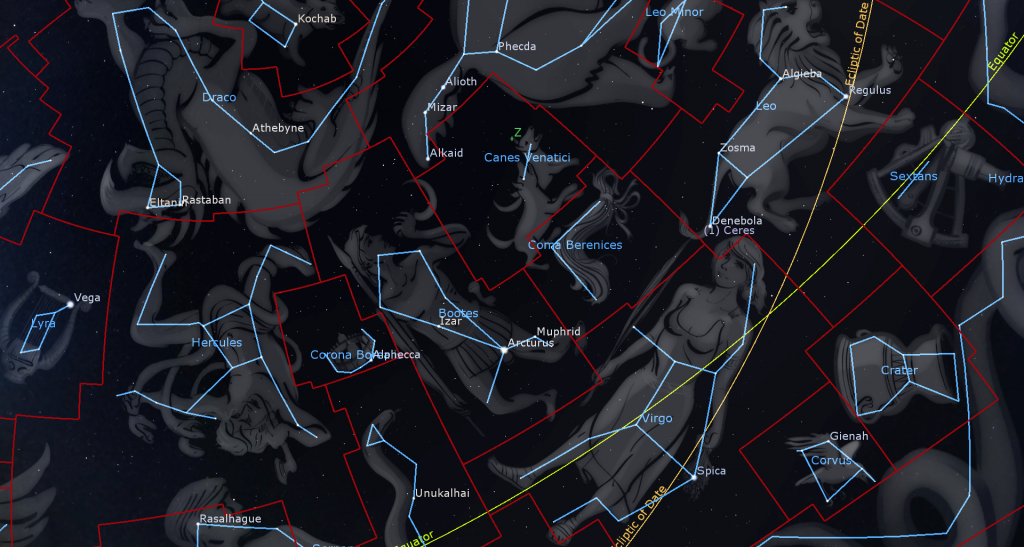
Let’s tour Boötes’ stars. A widely separated pair of medium-bright stars shine a fist’s diameter to Arcturus’ upper left (or celestial NNE). The lower, brighter one is Izar (ε Boötis), meaning “Loin Cloth”. (The word Boötis is Latin for “belonging to Boötes”. We’ll use “Boo” to shorten things.) The name Izar resembles Mizar, the star at the bend in the Big Dipper’s handle. That star also serves as a loin – of the bear.
A faint star named 34 Boo sits just half a finger’s width towards Arcturus from Izar. In a telescope, Izar itself splits into a gorgeous double star – with one partner golden and the other star white, or greenish, and tucked in very close to it. Those two companions are orbiting one another in a true binary star system some 200 light-years from our sun. A few finger widths to the upper right of Izar, on the upper (western) side of the kite, you’ll see a medium-bright star designated Rho Boötis (ρ Boo). This star marks the herdsman’s western hip. See if you can see a small star on the Izar side of Rho. That’s Sigma Boötis (σ Boo), a sunlike star 50 light-years away from us.
Making a jump about twice as far from Arcturus along the line drawn through Izar brings us to the herdsman’s eastern shoulder, a medium-bright star designated Delta Boötis (δ Boo) or Thiba. Thiba is a yellowish G8-class, sun-like star about ten times more massive than our sun. It is located 117 light-years away from our solar system.
A star named Nekkar “the Ox Driver” shines a generous palm’s width above (or 7.5° to the celestial northwest) of Thiba. Nekkar (or β Boo) marks the herdsman’s head and the top of the kite. Nekkar was originally a blue star. It’s now aging through a phase that is causing it to temporarily resemble a large version of our sun – on its way to becoming a brighter, red giant star.
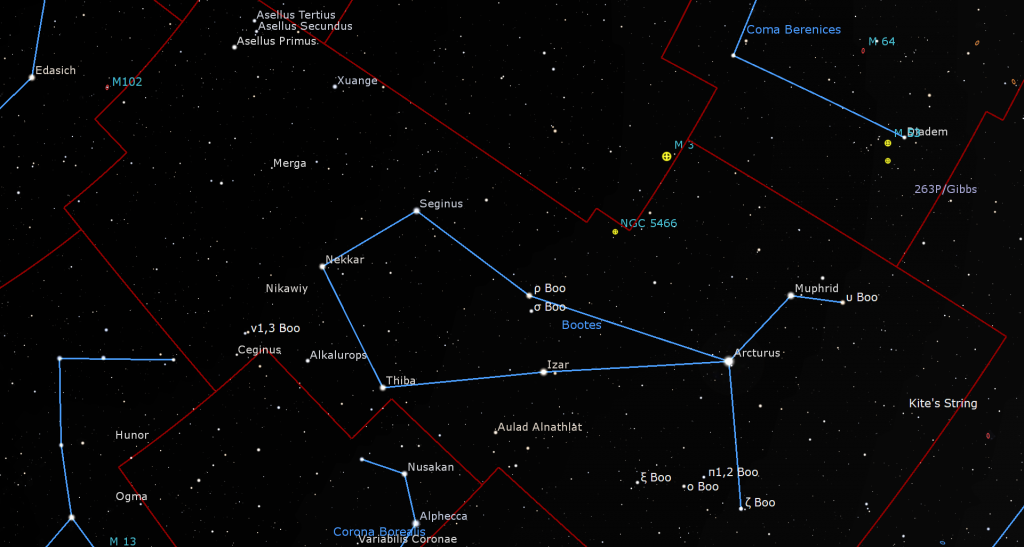
A medium-bright, triple star named Alkalurops (or Mu Boo), a name derived from “Shepherd’s Staff”, sits about four finger widths to the upper left (or 4.5° to the celestial northeast) of Thiba. It forms a squat triangle with Thiba and Nekkar. Two of Alkalurops’ stars can be discerned with sharp eyes or binoculars, and one of them splits into two stars when viewed through a telescope. All three stars are orbiting one another in a dance that takes at least 125,000 years for one orbit. Before moving on, position Alkalurops towards the right side of your binoculars’ field of view and look on the left for two close together stars named Nu Boötis or v1 and v2 Boo. The have dramatically different colours!
Above and between Nekkar and Rho Boo shines a bright star named Seginus or Gamma Boötis (γ Boo), which marks the herdsman’s western shoulder. Seginus is a white giant star that is evolving towards becoming a red giant one day. This 85 light-years-distant star is spinning about 70 times faster than our sun, which revolves once per month.
The medium-bright stars positioned to the lower right (celestial south) of Arcturus form the herdsman’s legs and feet. The left (eastern) foot, which sits less than a fist’s diameter below Arcturus, is designated Zeta Boötis (ζ Boo). In a telescope at high power it is revealed to be a nice, matched pair of close-together white stars. The medium-bright stars shining two finger widths to the upper left (northeast) of Zeta are whitish Pi Boo (on the right), which is another nice double star, and yellowish Omicron Boo (on the left). Double their distance to the fainter double star Xi Boo (ξ Boo).
Moving about four finger widths to the upper right from Arcturus, along Boötes’ western leg, brings us to the bright star Muphrid or Eta Boötis (η Boo), meaning “the Solitary star of the Lancer”. Murphrid too, has a composition similar to our sun. Even though it is actually the same distance away from us as Arcturus, its inherent brightness is lower, so it appears much dimmer in the sky. Dropping down slightly and moving farther to the right brings us to Upsilon Boötis (υ Boo), a very distant red giant star.
Boötes’ territory extends almost to the tip of the Big Dipper’s handle. A palm’s width below the bright star Alkaid at the tip of the handle, look for a tight grouping of three stars that represent the herdsman’s upraised hand. Their names are Asellus Primus, Asellus Secundus, and Asellus Tertius “First, Second, and Third Donkey” (and Theta, Iota, and Kappa Boo). The two higher (westerly) donkeys are telescopic double stars. The area around all three is a lovely, rich field for viewing because it’s full of small galaxies. The famous and easy-to-see Pinwheel Galaxy (Messier 101) is located only a few finger widths to the left (celestial north) from them!
All the stars within our galaxy are in motion, jostling about as they orbit the galactic centre every quarter of a billion years or so. Some stars move faster, or are located closer to us – so they exhibit a greater apparent motion compared with the surrounding stars. Astronomers call this phenomenon proper motion. That’s why star charts need to be updated about every ten years. Arcturus has a very high proper motion southward. In a few thousand years, the herdsman’s legs will be bent upwards with Arcturus below his knees!
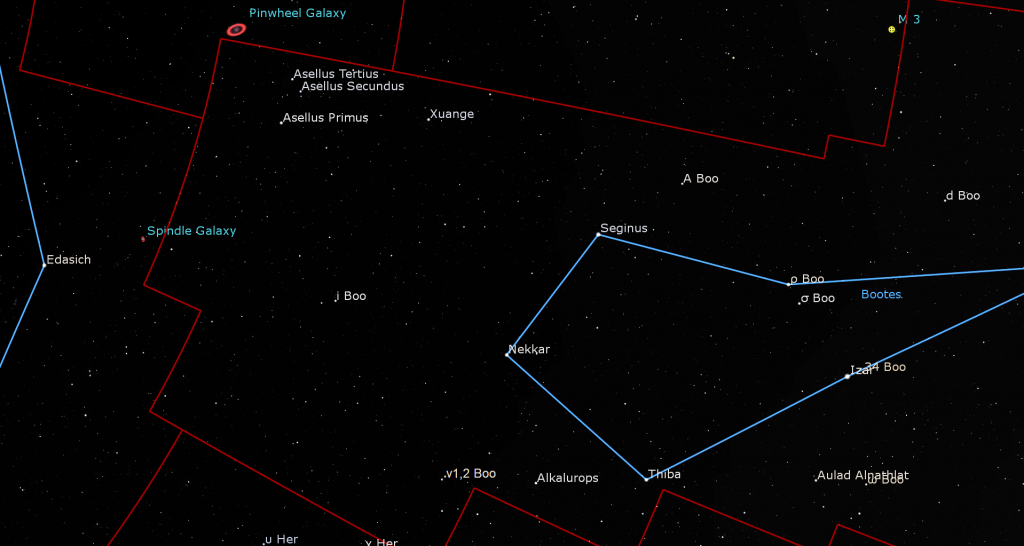
Positioned well off the Milky Way, Boötes hosts rather few bright deep sky objects. A palm’s width to the upper right (or 6 degrees to the celestial southwest) of Rho Boötis sits the globular star cluster known as the Snowglobe Cluster (or NGC 5466). It will appear as a small, fuzzy patch in binoculars and backyard telescopes under a dark sky. A further palm’s width to the upper right (or 5° to the celestial west) of the snowglobe, in next-door Canes Venatici (the Hunting Dogs), is the magnificent and much brighter globular cluster named Messier 3 – an easy object for urban stargazers. The constellation does host a great many faint, distant galaxies. One worth checking out is the terrific, magnitude 11 spiral galaxy NGC 5248, also known as Caldwell 45. It’s located in the southwestern corner of the constellation. Take the line drawn from Murphrid to u Boo and quadruple it.

Use your binoculars to seek out a short chain of 6 and 7 magnitude stars located below and between the herdsman’s feet. That kite’s string dangles towards the celestial equator and the bright star Spica below it!
Dark Sky Sights
If you missed my suggestions for deep sky objects to see on moonless May evenings, I posted it here.
Public Astro-Themed Events
Every Monday evening, York University’s Allan I. Carswell Observatory runs an online star party – broadcasting views from four telescopes/cameras (weather permitting), answering viewer questions, and taking requests! Details are here. They host in-person viewing on the first clear Wednesday night each month. On Wednesdays they stream views online via the observatory YouTube channel. Details are here.
At 7:30 pm on Wednesday, May 17, the RASC Toronto Centre will livestream their free monthly Speaker’s Night Meeting. This month, the speaker will be Conor W. Hayes, MSc, PhD candidate at York University. Their topic will be Water, Water Everywhere? A History of the Hunt for Lunar Water from Harold Urey to Artemis and Beyond. Check here for details and watch the presentation at https://www.youtube.com/rasctoronto/live.
My free, family-friendly Insider’s Guide to the Galaxy webcast with RASC National returns on Tuesday, May 23 at 3:30 pm EST. We’ll talk about how to plan a summer star party and what are the dos and don’ts for attendees. Then we’ll highlight our next batch of spring RASC Finest NGC objects. You can find more details and the schedule of future sessions here.
Keep looking up, and enjoy the sky when you do. I love questions and requests. Send me some!